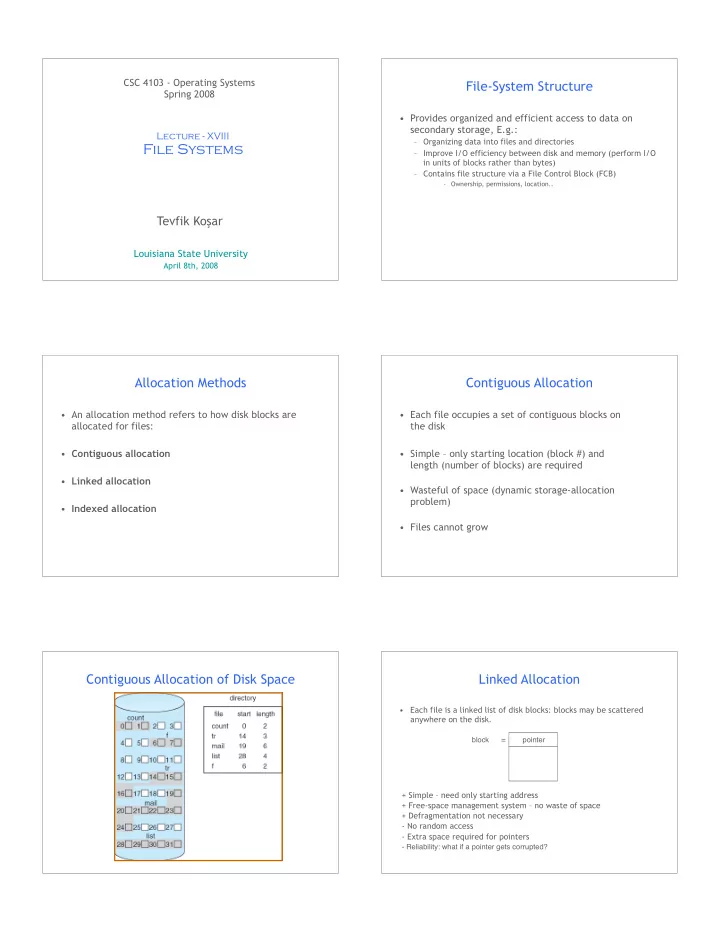

CSC 4103 - Operating Systems File-System Structure Spring 2008 • Provides organized and efficient access to data on secondary storage, E.g.: Lecture - XVIII – Organizing data into files and directories File Systems – Improve I/O efficiency between disk and memory (perform I/O in units of blocks rather than bytes) – Contains file structure via a File Control Block (FCB) – Ownership, permissions, location.. Tevfik Ko � ar Louisiana State University April 8th, 2008 1 Allocation Methods Contiguous Allocation • An allocation method refers to how disk blocks are • Each file occupies a set of contiguous blocks on allocated for files: the disk • Contiguous allocation • Simple – only starting location (block #) and length (number of blocks) are required • Linked allocation • Wasteful of space (dynamic storage-allocation problem) • Indexed allocation • Files cannot grow Contiguous Allocation of Disk Space Linked Allocation • Each file is a linked list of disk blocks: blocks may be scattered anywhere on the disk. block = pointer + Simple – need only starting address + Free-space management system – no waste of space + Defragmentation not necessary - No random access - Extra space required for pointers - Reliability: what if a pointer gets corrupted?
Linked Allocation File-Allocation Table Indexed Allocation Example of Indexed Allocation • Brings all pointers together into the index block, to allow random access to file blocks . • Logical view. index table + Supports direct access + Prevents external fragmentation - High pointer overhead --> wasted space Free Space Management Free-Space Management (Cont.) • Bit vector ( n blocks) • Disk space limited • Need to re-use the space from deleted files • To keep track of free disk space, the system maintains 0 1 2 n-1 a free-space list … – Records all free disk blocks 678 0 � block[ i ] free • Implemented using bit[ i ] = – Bit vectors 1 � block[ i ] occupied – Linked lists � e.g. 0000111110001000100010000
Free-Space Management (Cont.) Free-Space Management (Cont.) • Linked List • Bit map requires extra space – Example: block size = 2 12 bytes disk size = 2 30 bytes (1 gigabyte) n = 2 30 /2 12 = 2 18 bits (or 32K bytes) • Easy to get contiguous files • Linked list (free list) – Cannot get contiguous space easily – requires substantial I/O • Grouping – Modification of free-list – Store addresses of n free blocks in the first free block • Counting – Rather than keeping list of n free addresses: • Keep the address of the first free block • And the number n of free contiguous blocks that follow it 13 Acknowledgements • “Operating Systems Concepts” book and supplementary material by A. Silberschatz, P . Galvin and G. Gagne • “Operating Systems: Internals and Design Principles” book and supplementary material by W. Stallings • “Modern Operating Systems” book and supplementary material by A. Tanenbaum • R. Doursat and M. Yuksel from UNR 15
Recommend
More recommend